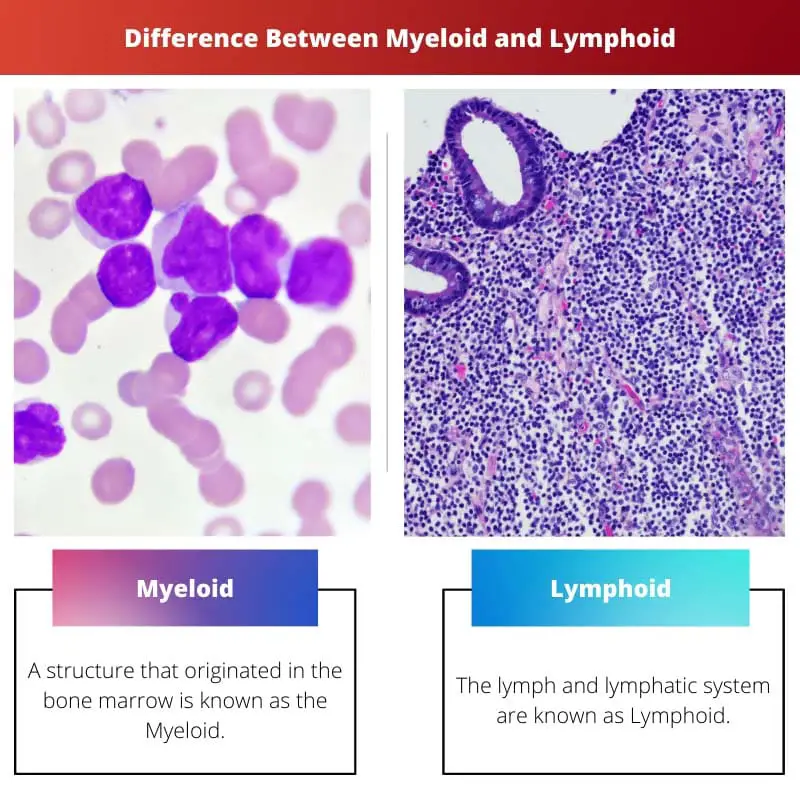Irrespective of the fact that Myeloid and Lymphoid both have the same suffix “–oid,” they are different from each other. Both terms refer to the components of a certain organ or structure found in the human body.
Myeloid refers to the structure of bone marrow, and lymphoid refers to the lymph or lymphatic system.
Key Takeaways
- Myeloid cells are produced in the bone marrow and include red blood cells, platelets, and various types of white blood cells, while Lymphoid cells are produced in the lymphoid organs and include T cells, B cells, and natural killer cells.
- Myeloid cells are involved in blood clotting, oxygen transport, and immune response, while Lymphoid cells are involved in the adaptive immune system.
- Myeloid cells are found in the blood and tissues, while Lymphoid cells are primarily found in the lymph nodes, spleen, and thymus.
Myeloid vs Lymphoid
Myeloid cells include red blood cells, platelets, and various types of white blood cells, such as neutrophils, basophils, eosinophils, monocytes, and macrophages. Lymphoid cells include B, T, and natural killer cells, which are involved in the immune response to infections and cancer.

Myeloid is a term used to define the structure that originates in the bone marrow of a human body and refers to an illness related to blood or occurring in the bone marrow. When there is a severe lack of red blood cells in the body, it leads to cancer in the bone marrow.
Lymphoid is a term used to define the composition of a human body known as lymph or lymphatic system, and the term is also used while describing a cancerous disease in the lymphatic system known as lymphoid leukaemia.
The lymphatic system of the human body is mainly responsible for its immune protection.
Comparison Table
| Parameters of Comparison | Myeloid | Lymphoid |
|---|---|---|
| Definition | A structure that originated in the bone marrow is known as the Myeloid. | The lymph and lymphatic system are known as Lymphoid. |
| Other definition | Myeloid is also used to define the illness occurring in the bone marrow. | Lymphoid is also used to define the illness occurring in the lymphatic system. |
| Disease development | It can occur in both RBC and WBC. | It occurs in the WBC only. |
| Subtypes | Myelodysplastic syndrome | Hairy cell leukemia |
| Types of malignancies | AML and CML. | ALL and CLL. |
What is Myeloid?
The myeloid term is used to describe the bone marrow structure in a human body, and the bone marrow contains myeloid cells, which are multipotent type stem cells.
The myeloid cells produce many types of blood cells in the body, namely red blood cells (RBC), granulocytes like monocytes, neutrophils, eosinophils, basophils, and platelets.
There are two types of malignancies that occur in the bone marrow known as acute myelogenous/myeloid leukaemia (AML) and chronic myelogenous/myeloid leukaemia (CML).
These two types of cancer happen due to the rapid growth of abnormal cells. Acute myelogenous/myeloid leukaemia (AML) is a fast-growing form of blood or bone marrow cancer.
Chronic myelogenous/myeloid leukaemia (CML) occurs in the blood-forming cells of bone marrow, and later with the span of time, it spreads to the bloodstream therefore, as the blood reaches other parts of the body, the disease spreads in the whole body.
There is another type of disease relating to myeloid known as Myelodysplastic Syndrome (MDS), in which there is an abnormal behaviour shown by the bone marrow as it produces a fewer amount of functioning red blood cells (RBC), white blood cells (WBC), or platelets in the body.
The cells in the blood and bone marrow seem to be abnormal when diagnosed.

What is Lymphoid?
Lymphoid, which describes the lymph or lymphatic system of the body, contains lymphoid cells, which are multipotent, hematopoietic progenitor cells.
The lymphoid cells are mainly responsible for producing T and B lymphocytes along with natural killer cells. T lymphocytes play a major role in boosting immunity.
B lymphocytes produce antibodies which play a major role in humoral immunity. Natural killer cells help to respond against virally infected cells.
There are two types of malignancies that occur in the lymphoid cells known as acute lymphoblastic leukaemia (ALL) and chronic lymphocytic leukaemia (CLL). These two types of cancer happen due to the production of immature lymphoblasts in large amounts.
In acute lymphoblastic leukaemia (ALL), the healthy cells which produce functioning lymphocytes are replaced rapidly, and thus, the cells remain immature.
These immature cells then flow in the bloodstream to different body parts, where the cells divide and grow, which results in various symptoms.
Chronic lymphocytic leukaemia (CLL) is a slow-growing cancer disease that occurs when abnormal lymphocyte growth obstructs normal cells, making it difficult to fight any infection.
The subtype of CLL, also known as hairy cell leukaemia (HCL), occurs when there is a large production of B cells.

Main Differences Between Myeloid and Lymphoid
- Myeloid refers to the structure that originated or is related to the bone marrow, whereas lymphoid refers to the body’s lymph or lymphatic system.
- The term myeloid is also used to refer to a cancerous illness that is related to or occurs in the bone marrow, whereas on the other hand, the term lymphoid is also used to refer to an illness relating to or which occurs in the lymphatic system.
- The myeloid disease develops and attacks both the white blood cells (WBC) as well as the red blood cells (RBC). On the other hand, the lymphoid disease known as lymphoid leukaemia attacks and develops in the white blood cells (WBC) only.
- Myelodysplastic syndrome is the subtype of myeloid-related disease in which the bone marrow produces a very less amount of functioning RBC, WBC, or platelets, and on the other hand, hairy cell leukaemia is the subtype of chronic lymphatic leukaemia in which the bone marrow produces too many B cells.
- In myeloid, AML and CML are the main types of malignancies, whereas in lymphoid, ALL and CLL are the main types of malignancies.

- https://www.nejm.org/doi/full/10.1056/nejm199909303411407
- https://www.nejm.org/doi/full/10.1056/NEJMra1406184
- https://www.nejm.org/doi/full/10.1056/NEJM199904293401706
- https://ashpublications.org/blood/article-abstract/107/9/3481/133476